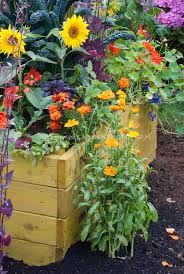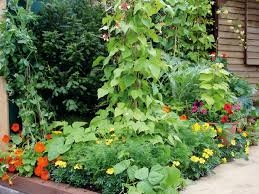
However, when it comes to setting the table with some sort of centerpiece, my garden frequently fails. I always plant vegetables first, and if there's room or time I'll add flowers. Not surprisingly, this means I have very few flowers for bouquets.
This year I'm giving thought to adding annual flowers to the vegetable patch. Because I have no more time this year than any other year, the flowers are going to have to earn their place. Not only must they be pretty, but they must serve a practical purpose as well. They will need to grow under the same conditions as the vegetables and not out-compete them for water and nutrients.
Flowers can indeed be practical additions to the kitchen garden. They might be edibles in their own right, embellishing salads and other foods. They might attract desirable insects, either pollinators like bees or predatory insects like ladybird beetles. And they might be useful as ground cover around taller vegetables. With these criteria in mind, I've been doing some research and coming up with lists of flowers to try.
Many plants produce edible flowers, including roses, most if not all herbs, and many vegetables. To find some annual flowers that are edible, I consulted The Edible Flower Garden by Rosalind Creasy, as well as an online list of edible flowers compiled by Colorado State University Extension. Here are some to try: calendula (Calendula officianalis), safflower (Carthamustinctorius), signet marigold (Tagetestenuifolia), African marigold (Tageteserecta), nasturtium (Tropaeolummajus), pansies and violas (Viola x wittrockiana and Viola tricolor).
I already have calendulas growing as weeds in the veggie patch, and I've grown nasturtiums and signet marigolds before. Since violas need cool weather, I won't grow them during the summer, but it might be fun to try the African marigolds and the safflowers.
For flowers that attract beneficial insects and bees, I found a useful list in Pam Peirce's Golden Gate Gardening. Her list includes many flowers in the daisy family: bachelor buttons, coreopsis (Coreopsis tinctoria), cosmos (Cosmos bipinnatus), daisies in general, feverfew (Anacetumparthenium), annual rudbeckia species, and sunflowers. Also suggested are bee balm (Monardaspp), annual blanket flower (Gaillardiapulchella), corn cockle (Agrostemma), evening primrose (Oenotheraspp), Mexican sunflower (Tithonia ), pincushion flower (Scabiosa), and sweet alyssum (Lobulariamaritima).
It won't be possible to grow everything. I want to grow some short flowering plants between my larger summer vegetables, like tomatoes, peppers and eggplant. I space tomatoes three to four feet apart when I set them out in spring, and I'd like to have something between to keep the ground covered. As the tomatoes grow, they may shade out the flowers, so I'll experiment with a few different flowers to see what works. I can try the same thing between the peppers and eggplants, which I space 18 to 24 inches apart.
A few cosmos or something similarly airy might mix well with the melons and squash plants, which do a great job of spreading and covering the ground but might appreciate a little light shade in the heat of summer. I will not plant anything that may become tall or bushy as I don't want to shade the vegetables too much.
Last year some volunteer zinnias thrived on the edges of one vegetable bed. They didn't receive any additional water and didn't seem to harm the nearby vegetables. Zinnias did not appear on any of my lists, but perhaps I could grow some of the suggested flowers on the edges of beds, particularly if they need little water.
After reviewing seed catalogs and online descriptions, I ordered seeds of bachelor buttons, cosmos, marigolds, monarda and scabiosa. All start readily from seed, grow in warm weather, and need moderate or little water. I already have nasturtium seed, and fever few naturalized in a corner of the yard several years ago. Most if not all of these plants make acceptable cutting flowers, too. I'm looking forward to a colorful vegetable patch and some improved table centerpieces this year.
Workshop: Napa County Master Gardeners will hold a workshop on “Propagation and Seed Starting” on Sunday, March 1, from 2 p.m. to 4 p.m., at Yountville Community Center in Yountville.Master Gardeners will discuss and demonstrate several types of propagation methods, including division, soft wood cuttings, grafting and seed starting. Learn about the tools and techniques that lead to successful propagation and have a hands-on experience. To register, contact the Parks and Recreation Department at 707-944-8712 or visit its web site.
Workshop: Napa County Master Gardeners will hold a workshop on “Warm-Season Vegetables” on Saturday, March 7, from 9:30 a.m. to 11:30 a.m., at the University of California Cooperative Extension office, 1710 Soscol Avenue, Napa. Learn the requirements for successfully growing summer vegetables from seed or from starts. Topics include soil type and temperature, best planting times; watering and fertilizing; managing common pests and diseases; and harvesting.
Online registration (credit card only)
Mail-in registration (cash or check only)
Master Gardeners are volunteers who help the University of California reach the gardening public with home gardening information. Napa County Master Gardeners ( http://ucanr.org/ucmgnapa/) are available to answer gardening questions in person or by phone, Monday, Wednesday and Friday, 9 a.m. to Noon, at the U. C. Cooperative Extension office, 1710 Soscol Avenue, Suite 4, Napa, 707-253-4143, or from outside City of Napa toll-free at 877-279-3065. Or e-mail your garden questions by following the guidelines on our web site. Click on Napa, then on Have Garden Questions? Find us on Facebook under UC Master Gardeners of Napa County.
Attached Images:
